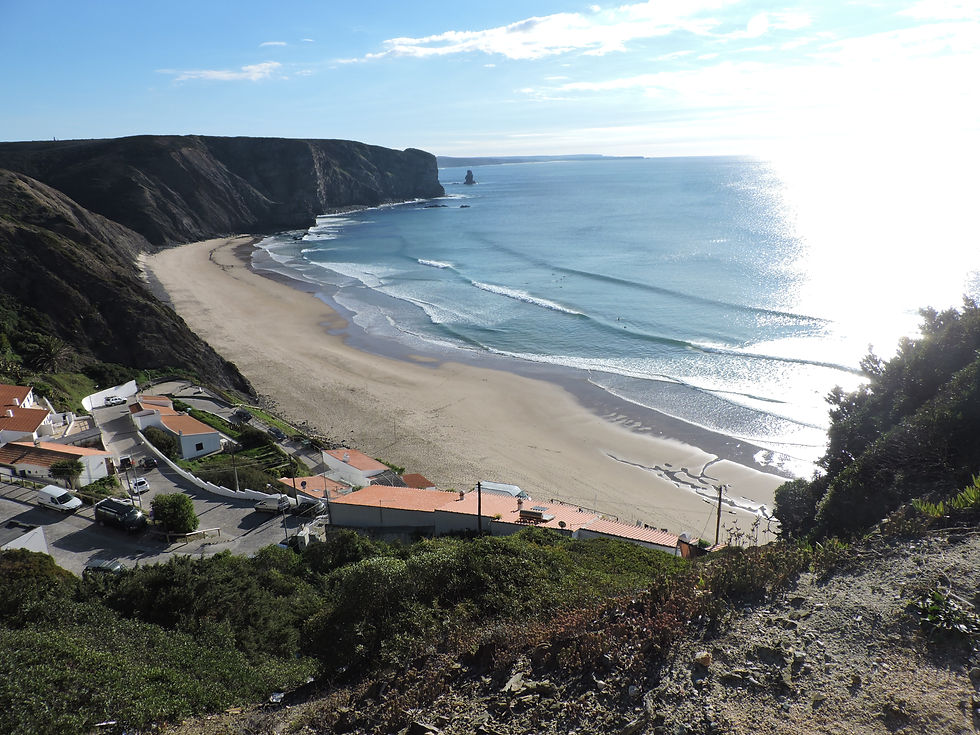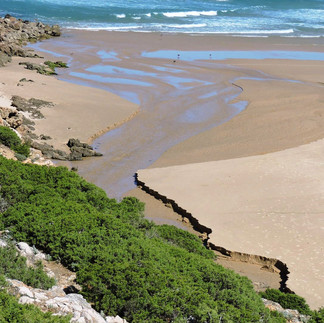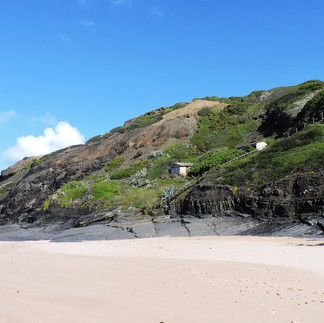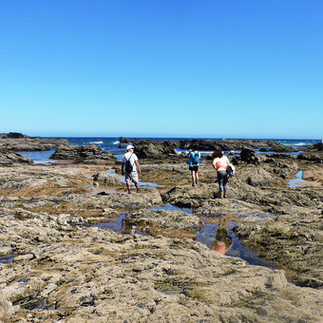10 Beaches to Visit in the Municipality of Aljezur
- Catarina Araújo

- Jul 25
- 7 min read

The municipality of Aljezur, located in the heart of the Southwest Alentejo and Vicentine Coast Natural Park, is a true haven for those seeking unspoilt beaches, breathtaking landscapes and trails that merge with the sea and the mountains. With a coastline stretching for dozens of kilometres, Aljezur offers a variety of beaches to suit all tastes — from secluded coves to large sandy beaches with support infrastructure.
In the centre of this municipality, the town of Aljezur still retains its rural and peaceful essence. Divided by the river of the same name — which rises in the Serra de Monchique and flows into Amoreira Beach — the town stretches along both banks: on one side, the older part, with the castle at the top of the hill, white houses and narrow cobbled streets; on the other, the newer area, developed in the 20th century. Walking through the streets of the village, you will find old community ovens, centuries-old churches, craft shops, markets with local produce and an atmosphere that blends the calm rhythm of the countryside with the seasonal bustle of tourism.
In this article, we take you on a journey through 10 unmissable beaches in the municipality of Aljezur, exploring trails, geological formations, cultural connections and the natural wealth that surrounds them.
1. Murração Beach
Murração Beach is one of the many ‘secrets’ of the Costa Vicentina. Hidden between high cliffs, this wild beach is known for its tranquillity and unspoilt environment. It is an ideal beach for those who enjoy walking, as access is not the easiest. There is a trail from Amado Beach that leads to Murração, part of the Rota Vicentina network of walking trails. You have to descend a rocky slope, but the effort is amply rewarded by the stunning scenery.
2. Amado Beach
Amado Beach is one of Europe's premier surfing spots. With consistent waves and several surf schools operating throughout the year, it attracts surfers of all levels. The bay is wide and protected by high cliffs, which provide some shelter from the wind and create impressive scenery.
In the dunes north of Amado Beach, there are traces of an ancient rural Islamic settlement dating from the 10th to 12th centuries, identified by archaeologists in recent decades. This is valuable evidence of the Muslim presence in the Algarve during the Middle Ages, at a time when the territory of the current municipality of Aljezur was part of Al-Andalus. The location of the settlement, relatively sheltered from the wind and close to the sea and wetlands with access to fishing and agriculture, reveals a strategic choice by the Islamic communities that lived here. It is estimated that the inhabitants lived from rain-fed agriculture, livestock farming and the harvesting of marine resources, in a lifestyle adapted to the environmental conditions of the Vicentine coast.
The Sítio do Forno restaurant, strategically located on the cliff, offers one of the best views of the Algarve coastline, ideal for a relaxed lunch with fresh fish from the coast.
The surrounding area is full of well-marked walking trails along the Rota Vicentina, which wind their way through rocks, scrubland and pine forests, offering close contact with Mediterranean and Atlantic flora.
3. Bordeira Beach
Bordeira Beach stands out for its extensive sandy beach, which, depending on the tide, can reach hundreds of metres in width. The Bordeira stream flows into the southern corner of the beach.
One of the most notable features of the beach is its dune system. Over thousands of years, strong and persistent coastal winds have carried sand inland. Over time, this sand has accumulated and been fixed by resistant vegetation. Rainfall and the presence of mineral salts contributed to the cementation of the sand and the formation of consolidated dunes, a type of sandy rock that now characterises the slopes of the beach. These dunes are important both for their geological uniqueness and for the biodiversity they harbour. The locals call the dunes ‘medos’.
Several trails integrated into the Rota Vicentina start from Bordeira, including boardwalk trails that cross the dunes and allow you to observe the landscape without damaging the ecosystem.
4. Canal Beach
Canal Beach is one of the wildest beaches in Aljezur. It has no lifeguards or beach facilities, which means it is rarely visited, making it ideal for those seeking peace and quiet and direct contact with nature. It can be reached via a narrow, somewhat rough dirt track or by following the coastal path from Arrifana Beach.
The beach is narrow, covered with pebbles and black rocks, and the cliffs surrounding it are rich in schist and gravel, hallmarks of the region's geology.
5. Arrifana Beach
Arrifana Beach is very popular with surfers due to its shell-shaped bay, which offers good conditions with consistent waves and shelter from the north wind, ideal for surfing throughout most of the year.
At the top of the cliff, it is worth visiting the ruins of the old Arrifana Fortress, built to protect the coast from attacks by pirates and privateers. The site offers superb views over the ocean.
One of the most striking features of the landscape at Arrifana Beach is the imposing Pedra da Agulha, a vertical rock formation that rises out of the sea at the southern end of the bay. With its tapered and dramatic silhouette, this natural ‘needle’ is the result of differential erosion of the rock, which resisted the force of the waves while the surrounding material was worn away over thousands of years. Pedra da Agulha is often photographed at sunset, its solitary shape cutting across the horizon. In addition to its scenic value, it also serves as a reference point for local surfers and fishermen, and is a true symbol of the Aljezur coast.
The footpaths around Arrifana Beach allow you to discover native flora species such as the sand everlasting (Helichrysum stoechas), easily recognisable by its intense aroma and golden yellow colour, or the discreet sea carrots (Daucus carota spp. halophilus), which sprout between rocks exposed to the salty wind. These trails also reveal historical sites such as Ponta da Atalaia, where the Ribat da Arrifana stands — a 12th-century Islamic fortification.

6. Monte Clérigo Beach
Monte Clérigo is one of the most family-friendly beaches in Aljezur. The small village adjacent to the beach gives it a special charm, with whitewashed houses and small restaurants facing the sea.
One of the beach's unique features is the presence of tide pools, which form between the rocks when the tide goes out. These pools are authentic natural aquariums, where you can observe anemones, small fish and sea urchins.
The stream that runs parallel to the beach creates an important wetland for birds and amphibians, and the trails that cross here lead to impressive viewpoints over the coastline.
7. Amoreira Beach
Amoreira Beach offers one of the most complete landscapes in the region: the fusion of the Aljezur river with the sea creates a natural lagoon that changes shape with the tide. It is an ideal beach for families, as the river area is shallow and safe for children.
Along the slopes, you will find vegetation typical of the Costa Vicentina, such as thyme, rosemary and sea lavender. The Rota Vicentina crosses this area with trails that allow you to explore the estuary and the coastline.
8. Carriagem Beach
Carriagem is an almost hidden beach, known mainly by those who enjoy walking and exploring secluded spots. You can get there on foot, following the Trilho dos Pescadores (Fishermen's Trail), but you can also leave your car in a small car park nearby. Then follow a narrow path through the bushes and descend a long, steep staircase.
The rock formations that stand out on the beach are impressive. These are steeply sloping shale beds, shaped by the action of the wind and sea. At low tide, rocky platforms emerge, revealing an amazing marine life — limpets, crabs, seaweed and even starfish.
9. Vale dos Homens Beach
Vale dos Homens is one of the wildest beaches, but it has some support infrastructure, including parking and access stairs.
The beach is surrounded by imposing geological formations composed of layers of schist, evidence of ancient tectonic transformations.
The Fishermen's Trail is well signposted and connects this beach to others. Nearby, the village of Rogil is known for its agricultural products, especially sweet potatoes and peanuts, making it ideal for a gastronomic detour.
10. Odeceixe Beach
Odeceixe Beach is perhaps the most iconic beach in Aljezur, and it is no coincidence that it was voted one of the ‘7 Wonders – Beaches of Portugal’. Located on the border between the Algarve and Alentejo regions, it is where the Ribeira de Seixe meets the sea, creating an extensive crescent-shaped sandy beach. The Ribeira de Seixe makes this beach very popular with families and kayakers.
The climb up to the viewpoint on the south side of the stream offers a fantastic view of the beach and the meandering stream.
The village of Odeceixe, with its narrow streets and traditional houses, complements the visit with cafés, restaurants and a strong cultural identity linked to agriculture and sustainable tourism.
Conclusion
The beaches of Aljezur reveal a landscape shaped by the force of the sea, ancient history and vegetation resistant to wind and salt. Whether for their scenery, trails or tranquillity, each beach has something unique to offer.
It is worth taking the time to explore this coastline carefully, letting yourself be guided by the paths of the Rota Vicentina and the local people who still live in harmony with nature.
FAQs
Which beach is best suited for children?
Amoreira Beach, thanks to its calm waters, is ideal for families with children.
Are there trails between several of these beaches?
Yes, the Rota Vicentina connects many of these beaches via well-marked coastal and rural trails.
Where can you find good places to eat?
Restaurants such as Sítio do Forno (Amado Beach) and establishments in Monte Clérigo and Odeceixe are good choices.
When is the best time of year to visit Aljezur?
Spring and early autumn are ideal — less crowds and mild weather, perfect for walking and swimming.
Do the beaches have parking?
Some are (Arrifana, Monte Clérigo, Odeceixe), others require trails or access via dirt roads (Murração, Canal, Carriagem).






































































































































































Comments